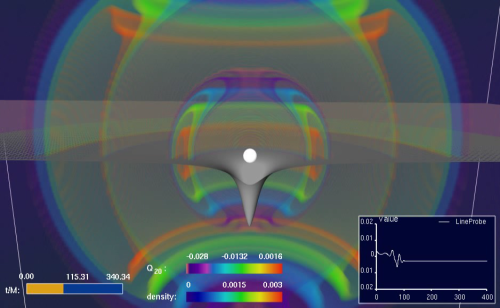From Wikipedia, the free encyclopedia
 |
This is a file from the Wikimedia Commons. The description on its description page there is shown below.Commons is a freely licensed media file repository. You can help.
|
Summary
This image is a snapshot from a simulation of a star collapsing to form a black hole and emitting gravitational waves in the process. The white sphere in the centre is the black hole's apparent horizon; the colorful wisps around it are the gravitational waves (l=2, m=2 multipole waves); the inset on the bottom right shows how the waveform would be perceived by a distant observer.
The image was produced by the Numerical Relativity Group of the Max Planck Institute for Gravitational Physics (Albert Einstein Institute).
The group's leader, L. Rezzolla, has agreed to share this image under the Creative Commons Attribution-Share Alike Licenses 2.5 and 3.0, where the attribution should be to
- L. Rezzolla (AEI) and R. Kähler (ZIB)
with the associated URL
Licensing

  |
This file is licensed under the Creative Commons Attribution ShareAlike 2.5 License. In short: you are free to share and make derivative works of the file under the conditions that you appropriately attribute it, and that you distribute it only under a license identical to this one. Official license |
File history
Click on a date/time to view the file as it appeared at that time.
|
|
Date/Time |
Thumbnail |
Dimensions |
User |
Comment |
| current |
14:08, 13 June 2007 |
 |
500×308 (155 KB) |
Mapos |
|
File links
The following pages on Schools Wikipedia link to this image (list may be incomplete):

